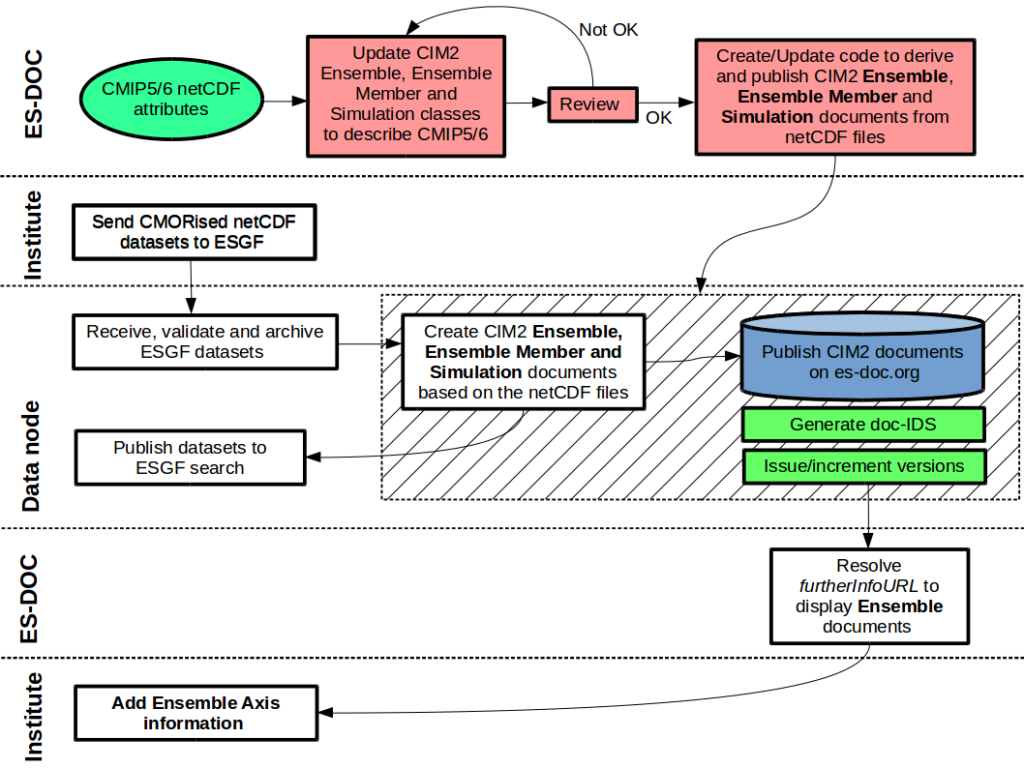CMIP6 – Simulations & Ensembles
A simulation is an integration of a model carried out for an experiment, which in turn is part of a MIP. All simulations belong to an ensemble of simulations, even if there is only one ensemble member. Due to the large number of ensembles and simulations that will be created for CMIP6, ensemble and simulation descriptions will be almost entirely auto-generated from the CMIP6 datasets submitted to the ESGF archives, meaning that there will be very little effort required from the modelling groups.
When valid CMIP6 datasets are submitted to an ESGF archive, their netCDF metadata are read on the ESGF node to determine which ensembles and simulations the datasets were created for. This is done automatically as part of the ESGF publication process. The raw descriptions of these ensembles and simulations are then automatically sent to ES-DOC for publication.
Each CMIP6 netCDF file contains an attribute called “further_info_URL” which is the URL of a landing page from which all of the relevant documentation relevant to the data may be accessed. This landing page will describe the ensemble for which the simulation was run and will contain links to documentation for the ensemble’s experiment, the simulation itself and any other simulations that the ensemble may contain. Each Simulation document contains a link to the description of the model that ran it.
A small amount of manual input may be required to describe how the simulations vary across the four “ensemble axes”, i.e. the realization (r), initialization (i), perturbation (p) and forcing (f) axes of the ensemble. If the ensemble does not vary along one of these axes then no action is necessary. Note that even if an ensemble contains only one simulation, an ensemble document is still created. Entering this information will be straightforward, since where ever extra information is required, the further_info_URL will contain a direct link to an on-line questionnaire form in which it can be edited.
The workflow is illustrated here, demonstrating that after sending datasets to the ESGF archive, no further action is required from a modelling institute until after the further_info_URL has been automatically created, when the ensemble axis information (if any) needs to be added:
Extra effort will also be required to detail how each ensemble of simulations conformed to the experiment’s requirements, which is covered in the next section.
Conforming to the experimental requirements
Each experiment has a number of requirements which all of its simulations are expected to conform to. For example, an experiment may have the requirement that all simulations must start and end on particular dates. The requirements for each experiment of each MIP can be seen in the ES-DOC documentation viewer. It is essential to document how these requirements were met for each experiment’s ensemble. To make this task easier it is assumed that an ensemble fully conforms to its experiment’s requirements unless otherwise stated, so that only cases which require additional information (such as describing the interpolation of an input dataset) or for which conformance was partially, or not, achieved (such as using equivalent concentrations of an alternative gas for radiative forcing) need to recorded by hand.
ES-DOC will provide spreadsheets that are pre-seeded with experimental requirements and in which the conformance to each requirement may be recorded. In these spreadsheets, entering no information is equivalent to stating that the requirement was conformed to, so it is only necessary to provide details for the minority of cases for which conformance was not fully achieved.

